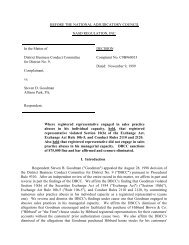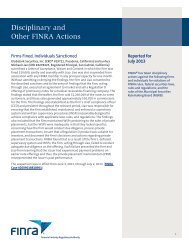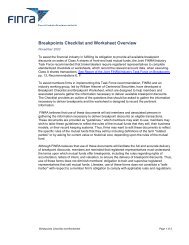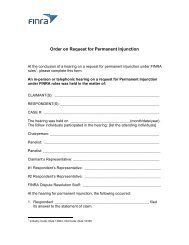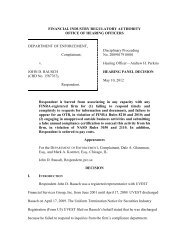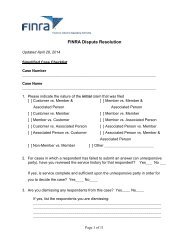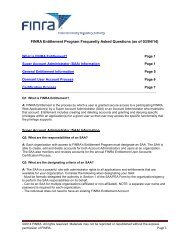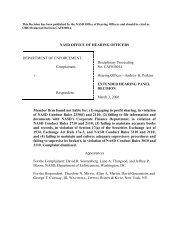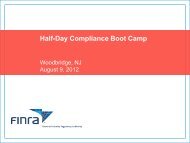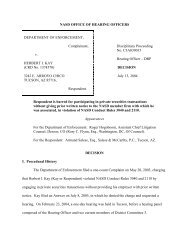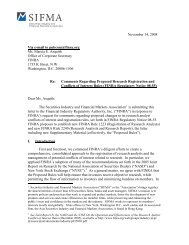NAC Disciplinary Decision Complaint No. 2008011701203 - finra
NAC Disciplinary Decision Complaint No. 2008011701203 - finra
NAC Disciplinary Decision Complaint No. 2008011701203 - finra
Create successful ePaper yourself
Turn your PDF publications into a flip-book with our unique Google optimized e-Paper software.
BEFORE TIlE NATIONAL ADJI. IDICATORY ()UNCl I.<br />
FINANCIAL INDUSTRY REGUI A’1ORY AU’li IORITY<br />
In the Matter of<br />
1)epartment of’ I n Forcement,<br />
Dl C’ IS ION<br />
Qomphiinant, (‘omplaint <strong>No</strong>. 2008011 70 I 203<br />
vs. Dated: I)ecemher 12, 2012<br />
l)aniel James Gallagher<br />
Port Washington, NY,<br />
Respondent.<br />
Respondent acted as an unregistered principal, refused to respond to<br />
questions (luring on-the-record testimony, willfully failed to amend his Form<br />
U4, circumvented heightened supervision requirements, failed to adopt a<br />
supervisory control system, and failed to conduct an annual certification of<br />
the supervisory control system. held, findings affirmed anti sanctions<br />
affirmed in part.<br />
Appearances<br />
For the Complainant: Leo F. Orenstein. Esq..Vaishali S. Shetty, Esq., Department of<br />
Enforcement, Financial Industry Regulatory Authority<br />
For the Respondent: Pro Se<br />
<strong>Decision</strong><br />
Daniel James Gallagher appeals a Hearing Panel decision issued on June 13, 2011. The<br />
1-learing Panel found that Gallagher violated several of FINRA’s rules because he: (1) acted as an<br />
unregistered principal, (2) refused to respond to questions during on-the-record testimony, (3)<br />
willfully failed to amend his Uniform Application for Securities Industry Registration or<br />
Transfer (“Form U4”) to disclose a Commission complaint and judgment. (4) circumvented<br />
heightened supervision requirements, and (5) failed to adopt a supervisory control system and<br />
conduct an annual certification of the supervisory control system.<br />
The Hearing Panel barred Gallagher for acting as an unregistered principal, barred him<br />
for circumventing heightened supervision requirements, and barred him for refusing to respond<br />
to questions during on-the-record testimony. The Hearing Panel stated that it would have<br />
imposed sanctions of less than a bar for Gallagher’s willful failure to amend his Form U4, failure<br />
to adopt a supervisory control system, and failure to conduct an annual certilication of the
Vision<br />
supervisory control system, bitt the I learing Panel declined to impose these additional sanctions<br />
in light of the bars that it had imposed l’or the other causes of’ action.<br />
Af’ter an independent review of’ the record, we aI’firm the 1 learing Panel’s findings of’<br />
violation and affirm, in part, the I learing Panel’s sanctions. Specifically, we af’Iirin the bar for<br />
( ial lagher’s acting as an unregstered pi’incipal, the bar for his i’efusal to respond to questions<br />
during on—the—recoi’d testimony, and the bar I’or Gallagher’s circumvention of heightened<br />
supervision requirements. We discuss the remaining sanctions later in this decision.<br />
I. Gallaeher and Vision Securities. Inc.<br />
Gallagher entered the securities industry in August 1990, when he registered as a general<br />
securities representative with a former FINRA lirm. Gallagher remained registered with FINRA<br />
continuously l’rom August 1990 until the termination of his most recent association in June 2011.<br />
l)uring the period relevant to the conduct in this case, Gallagher was registered as a general<br />
securities representative with Vision Securities, Inc. Gallagher joined Vision Securities in May<br />
2001 , Securities terminated Gallagher’s association with the Firm in January 2010. when<br />
FINRA cancelled the Firm’s niembci’ship for its failure to pay outstanding lees,<br />
II.<br />
Procedui’al I listory<br />
This case results l’rom a routine cycle examination that began in .January 2008. In August<br />
2010, FINRA’s I)epartmenl of Enforcement liled an amended eight—cause complaint against<br />
Gallagher and Vision Securities,<br />
1<br />
The lirst cause of action alleged that Gallagher acted as an unregistered principal of<br />
Vision Securities, in violation of NASD Rules 1021(a) and 2110. The second cause ol’action<br />
alleged that Gallagher circumvented heightened supervision requirements that Maryland, New<br />
Jersey, New York, and FINRA imposed on him, in violation of NASD Rule 2110. The third<br />
cause of action alleged that Gallagher failed to adopt a supervisory control system and conduct<br />
an annual certification of the supervisory control system, in violation of NASD Rules 3012,<br />
3013, and 2110.2 The seventh cause of action alleged that Gallagher refused to respond to<br />
I<br />
Enforcement filed the original six-count complaint against Gallagher and Vision<br />
Securities in February 2010. The amended complaint added two causes of action against<br />
Gallagher, incorporating a cause of action for Gallagher’s refusal to respond to questions during<br />
on-the-record testimony and a cause of action for his willful failure to amend his Form U4 to<br />
disclose the Commission’s complaint and judgment.<br />
2<br />
Enforcement named Gallagher and Vision Securities as joint respondents in causes one,<br />
two, and three. Causes four, five, and six concerned only Vision Securities, while causes seven<br />
and eight related only to Gallagher. The fourth cause of action alleged that Vision Securities<br />
failed to report, accurately report, and maintain NASD Rule 3070 filings, and asserted that<br />
Vision Securities failed to update and timely update Forms U4 and Uniform Termination <strong>No</strong>tices<br />
for Securities Industry Registration (“Forms U5”). The fifth cause of action alleged that Vision<br />
Securities failed to conduct independent anti-money laundering testing. The sixth cause of<br />
action alleged that Vision Securities failed to administer and maintain records of its continuing<br />
[Footnote continued on next page]
-3-<br />
Iluest ions during on-the-record testimony, in violation o F Ii NRA Rules 82 1 0 and 201 Finally,<br />
the eighth cause of action alleged that Gallagher will Fully Fuiled to amend his Form U4 to<br />
disclose a Commission complaint and judgment, in violation of NASI) Rule 2110 and lINRA<br />
Rule 2010.<br />
A two—day hearing took place in New York in .January 2011 . Six witnesses testified at<br />
the hearing, including Gallagher and two of Vision Securities’ Furmer employees. The I learing<br />
Panel issued its decision in .June 2011 . ‘I’his appeal followed.<br />
Ill.<br />
Discussion<br />
A. Gallagher Acted as an Unregistered Principal<br />
The I learing Panel found that Gallagher violated NASI) Rules 1 021(a) and 2110 because<br />
he acted as an unregistered principal of Vision Securities. 4 We allirm.<br />
1. NASDRuIc 1021<br />
NASD Rule 1021(a) states that, “laill persons engaged or to be engaged in the investment<br />
banking or securities business of a member who are to function as principals shall be registered<br />
as such with NASD.” NASD Rule 1 021(b) defines the term “principal” and states that principals<br />
are “[p]ersons associated with a member... who are actively engaged in the management of the<br />
member’s investment banking or securities business, including supervision, solicitation, conduct<br />
of business or the training of persons associated with a member for any of these functions.” An<br />
individual is “actively engaged in the management of the member’s investment banking or<br />
securities business,” and consequently, should register as a principal, when the individual is<br />
involved in the “day—to—day conduct of the member’s securities business and the implementation<br />
of corporate policies related to such business.” NASD <strong>No</strong>tice to Members 99-49, 1999 NASD<br />
[cont’dl<br />
education programs. The Hearing Panel censured Vision Securities and imposed a fine of<br />
$60,000 under causes one through six. Vision Securities did not appeal these sanctions.<br />
In October 2010, Enforcement moved for partial summary disposition on this cause of<br />
action. Gallagher opposed the motion. The Hearing Panel rendered a decision on the motion in<br />
December 2010, before the hearing began. The Hearing Panel granted Enforcement’s motion as<br />
to liability, but reserved a determination of sanctions until after the hearing occurred.<br />
We discuss the rules in effect when the conduct occurred. Enforcement alleged no<br />
independent theory of liability for a violation of NASD Rule 2110 for this cause of action;<br />
however, a violation of any FINRA rule constitutes conduct inconsistent with high standards of<br />
commercial honor and just and equitable principles of trade and violates NASD Rule 2110. Sec<br />
Dennis Todd Lloyd Gordon, Exchange Act Rd. <strong>No</strong>. 57655, 2008 SEC LEXIS 819, at *4 n.3<br />
(Apr. 11, 2008). NASD Rule 2110 states that, “a member, in the conduct of his business, shall<br />
observe high standards of commercial honor and just and equitable principles of trade.” NASD<br />
Rule 0115 subjects associated persons to all rules applicable to FINRA firms.
-4-<br />
Ii XIS 24, at *2 (.June 1999) (stating that registration determination turns on functions that<br />
individual performs).<br />
2. (iallaher’s Activities at Vision Securities<br />
Between l)ecember 2006 and October 2007, Gallagher served as Vision Securities’<br />
president and was the secretary and chairman of’ Visioii Securities’ board of’ directors. During<br />
this same period, Gallagher also was part—owner of Vision Securities’ parent company, GCG<br />
I loldings, Inc., acted as GC’G I loldings’ president, and served as the chairman of’ GCG I loldings’<br />
hoard of’ directors. Although Gallagher was not registered as a principal, he actively engaged in<br />
the management of’ Vision Securities’ securities business and was involved in the firm’s day—to<br />
day operations. 5<br />
For example, Gallagher recruited, hired, and fired several of Vision Securities’ key<br />
employees, including the firm’s financial and operations principal (“FINOP”), bookkeeper, two<br />
chief compliance oflicers, and two successor presidents. 6 Tie supervised Vision Securities’<br />
personnel, directed the filing of Forms U4 and U5 at the firm, and unilaterally controlled the<br />
firm’s finances, including commission payments to registered representatives and service<br />
payments to vendors. 7 Gallagher also held himself out as a supervising principal in<br />
correspondence and contracts with Vision Securities’ customers, clearing firm, and vendors. 8<br />
In late 2001 or early 2002, Gallagher applied to take the General Securities Principal<br />
Qualification Fxamination (Series 24). FINRA initially approved the application and opened a<br />
120-day “window” for Gallagher to take the qualifying examination between January and May<br />
2002. Gallagher, however, allowed the window to expire after FINRA notified him that he was<br />
not permitted to obtain a principal’s registration. As discussed in further detail below, certain<br />
restrictions that Maryland, New Jersey, and New York imposed on Gallagher prohibited him<br />
from holding any supervisory or principal position at Vision Securities or any other FINRA firm.<br />
See infra Part IIl.D (Gallagher Circumvented Heightened Supervision Requirements).<br />
6<br />
The hiring and firing of a firm’s personnel are activities that favor principal registration.<br />
See Gordon, 2008 SEC LEXIS 819, at *27 (determining that employee’s hiring and firing of<br />
firm’s registered representatives supports that employee acted as unregistered principal); Richard<br />
F Kresge, Exchange Act Re!. <strong>No</strong>. 55988, 2007 SEC LEXIS 1407, at *50 (June 29, 2007)<br />
(finding that employee’s active involvement in firm’s hiring demonstrates that employee acted as<br />
unregistered principal).<br />
Supervision of a firm’s employees and control of a firm’s finances are activities that<br />
suggest that an associated person is actively engaged in a firm’s securities business and should<br />
register as a principal. See Kresge, 2007 SEC LEXIS 1407, at *50 (finding that employee’s<br />
“substantial role” in firm’s finances supports that employee acted as unregistered principal);<br />
Vladislav Steven Zubkis, 53 S.E.C. 794, 799-800 (1998) (explaining that applicant’s financial<br />
support of firm evidences need for principal registration).<br />
8<br />
The representations, which an associated person may make concerning his or her<br />
supervision and control of a FINRA firm, are part of the assessment of whether principal<br />
registration is necessary. See Gordon, 2008 SEC LEXIS 819, at *27 (concluding that employee<br />
acted as unregistered principal where, among other things, he held himself out to third parties as<br />
[Footnote continued on next page]
-s<br />
On appeal, (lal higher stales that Vision Securities employed several general securities<br />
principals during the relevant period. lYNRA knew that these individuals were registered with<br />
Vision Securities as principals, and lIN RA communicated with these individuals in their<br />
principal capacities. Gallagher concludes that the presence ol other general securities principals<br />
at Vision Securities, and hi NRA’s acknowledgement ol’ the principals at the lirm. establishes<br />
that he could not have acted as an unregistered principal. Gallagher’s argument misses the point.<br />
‘Ihe presence oF other general securities principals at Vision Securities has no bearing on<br />
Gallagher’s activities at the firm. To the contrary, the record establishes that (lallagher engaged<br />
in numerous activities that required registration as a principal, activities such as hiring, firing.<br />
and Supervision.<br />
Gallagher’s activities at Vision Securities, his managerial and supervisory role at the<br />
firm, and his control, ownership, and position with Vision Securities’ parent company, GCG<br />
I loldings, demonstrate that Gallagher actively engaged in Vision Securities’ securities business,<br />
managed the lirm’s day-to-day operations, and consequently, acted as an unregistered principal.<br />
Gallagher therefore violated NASI) Rules 102 1(a) and 2110.<br />
13. Gallagher Refused to Respond to Questions During Oti-the-Record<br />
Testimony<br />
The hearing Panel found that Gallagher violated FINRA Rules 8210 and 2010 because<br />
he refused to respond to questions during on-the-record testimony. We affirm.<br />
1. FINRA Rule 8210<br />
9<br />
FINRA Rule 8210 requires that associated persons provide information orally or in<br />
writing with respect to any matter involved in a FINRA investigation, complaint, examination, or<br />
proceeding. Because FINRA lacks subpoena power, it must rely on FINRA Rule 8210 “to police<br />
the activities of its members and associated persons.” Joseph Patrick Hannan, 53 S.E.C. 854,<br />
858-59 (1998). “Delay and neglect on the part of members and their associated persons<br />
undermine the ability of [FTNRA] to conduct investigations and thereby protect the public<br />
interest.” Paz Secs., Inc., Exchange Act Re!. <strong>No</strong>. 57656, 2008 SEC LEXIS 820, at *1213 (Apr.<br />
11, 2008); see also Morton Bruce Erenstein, Exchange Act Re!. <strong>No</strong>. 56768, 2007 SEC LEXIS<br />
[cont’ d]<br />
having authority to communicate for and make commitments on behalf of firm); Kirk A. Knapp,<br />
50 S.E.C. 858, 861 (1992) (considering applicant’s representations concerning his supervision of<br />
firm to customers and third parties as factor supporting principal registration).<br />
A vio!ation of any FINRA rule, including FINRA Ru!e 8210, violates FINRA Ru!e 2010.<br />
See Dep ‘1 ofEnforcement v. Reichman, <strong>Complaint</strong> <strong>No</strong>. 200801201960, 20!! FINRA Discip.<br />
LEXIS 18, at *28.29 (FINRA <strong>NAC</strong> July 21, 2011) (finding that respondent’s refusal to respond<br />
to request made pursuant to FINRA Rule 8210 violated FINRA Rule 2010). NASD Rule 2110,<br />
FINRA’s ethical standards rule, was transferred without change to FINRA’s consolidated<br />
rulebook and codified as FINRA Rule 2010. See FINRA Regulalomy <strong>No</strong>tice 08-57, 2008 FJNRA<br />
LEXIS 50, at *32..33 (Oct. 2008). FINRA Rule 0140 subjects associated persons to all rules<br />
applicable to FINRA firms.
- 6<br />
-<br />
2596, at *24 (<strong>No</strong>v. 8. 2007) ( finding that applicant’s reFusal to respond to questions about his lax<br />
return viokited NAS I) Rule 82 1 0).<br />
FYNRA Rule 8210 is unequivocal and grants FINRA broad authority to obtain<br />
information concerning an associated person’s securities—related business ventures. See Dep ‘I of<br />
I1iforcL’nlL’1l! 1’. I’clIt’c(’fl. (‘omplaint <strong>No</strong>. (‘9A040024. 2007 NASI) I)iscip. LEXIS 2, at *2<br />
(NASI) <strong>NAC</strong> .Jan. 8.2007), afj’d. Exchange Act Rd. <strong>No</strong>. 56770, 2007 SEC LEXIS 2598. at *1<br />
(<strong>No</strong>v. 8, 2007). Associated persons therefore must cooperate Fully in providing FINRA with<br />
information and may not take it upon themselves to determine whether the information FINRA<br />
has requested is material. See (‘MG Ins!. Trading, LL(’, Exchange Act Re!. <strong>No</strong>. 59325, 2009<br />
SEC LIiXIS 215, at *21 (.Jan. 30, 2009) (stating that associated persons “may not ignore NASD<br />
inquiries . . nor take it upon themselves to determine whether information is material to an<br />
NASD investigation of’ their conduct”).<br />
2. Gal laher’ s On-the-Record Testimony<br />
In September 2009, questions began to arise concerning Vision Securities’ net capital<br />
compliance. 10 FINRA’s district office therefore issued a warning letter to Vision Securities,<br />
explaining that the firm should cease operations until its net capital compliance could be verified.<br />
Shortly after issuance of the warning letter, an examiner in the district office learned that a<br />
company. named Nano Acquisition Group, LLC, was operating from Vision Securities’ offices,<br />
had initiated an offering of securities to raise caFilal for the company, and had marketed the<br />
offered shares to Vision Securities’ customers. I laying received this information, the examiner<br />
in the district office sent Gallagher and Vision Securities requests for information and documents<br />
and requested that Gallagher appear to provide on-the-record testimony concerning Nano<br />
Acquisition Group. The examiner requested information concerning the company’s offering to<br />
determine whether Vision Securities was operating without sufficient net capital and whether<br />
Gallagher was participating in undisclosed private securities transactions.<br />
Gallagher’s on-the-record testimony was scheduled for April 12, 2010. Although<br />
Gallagher appeared to provide testimony, he refused to respond to the examiner’s questions<br />
10<br />
A FINRA examiner became concerned about Vision Securities’ net capital compliance<br />
after the Commission obtained a civil judgment against Gallagher and the firm in August 2009.<br />
See infra Parts IlI.C.2 (Gallagher Failed to Disclose the Commission’s <strong>Complaint</strong> and Judgment<br />
Against him) and IV.A (Gallagher I-has an Extensive <strong>Disciplinary</strong> History). The civil judgment<br />
required that Gallagher and Vision Securities pay, jointly and severally, $179,718 in<br />
disgorgement, prejudgment interest, and civil penalties.<br />
Nano Acquisition Group was a limited liability company formed in Delaware in<br />
September 2009. The company’s principal place of business was in Port Washington, New<br />
York, where Gallagher resided. According to Nano Acquisition Group’s offering documents, the<br />
company was “formed to acquire the stock or assets, in whole or in part, of Nanodynamics. Inc.,<br />
a company currently in [b]ankruptcy.” Nanodynarnics owned several patented technologies,<br />
including a solid oxide fuel cell technology. In April 2012, a jury found that Nano Acquisition<br />
Group’s offering was a fraudulent investment scheme and found Gallagher guilty of securities<br />
and wire fraud. See infra Part IV.A (Gallagher Has an Extensive <strong>Disciplinary</strong> I-history).
-7-<br />
concerning Nano Acquisition Group. In Some instances, Gallagher refused to respond to the<br />
questions because he believed (hat lINRA lacked jurisdiction to investigate his involvement with<br />
Nano Acquisition Group. In other instances, Gallagher refused to respond because lie said that<br />
he did not trust that (lie examiner was able tO protect (lie conlidentialiiy of Nano Acquisition<br />
Group’s ollering. At several junctures during Gallagher’s on—the—record testimony, lie stated that<br />
he intended to respond to the examiner’s questions, but he would do so at some later date. When<br />
Gallagher refused to respond to the questions regarding Nano Acquisition Group. the examiner<br />
advised Gallagher that his failure to respond violated FINRA Rule 821 0. Gallagher, however,<br />
still refused to respond.<br />
Gallagher also did not answer questions about other matters involving Nano Acquisition<br />
Group, including his compensation, emails about Nano Acquisition Group that lie sent from his<br />
email account at Vision Securities, and whether his work for Nano Acquisition Group constituted<br />
undisclosed private securities transactions. Gallagher’s complete lack of responsiveness on April<br />
12, 2010, required a continuance oI’the on—the—record testimony on April 26, 2010.Just as lie<br />
did during his earlier testimony, Gallagher refused to respond to any of the examiner’s questions<br />
concerning Nano Acquisition Group, even after the examiner reminded him that a failure to<br />
respond during on—the—record testimony violated FINRA’ s rules.<br />
On appeal, Gallagher reasserts that FINRA did not have jurisdiction to inquire about his<br />
involvement with Nano Acquisition Group or his marketing of the company’s securities to<br />
customers of Vision Securities. Gallagher misunderstands the reach of FINRA Rules 821 0 and<br />
2010. These rules provide FINRA with broad discretion to inquire about any matter involved in<br />
a FINRA investigation, complaint, examination, or proceeding. See Dennis’ A. Pearson, J,<br />
Exchange Act Rd. <strong>No</strong>. 54913, 2006 SEC LEXIS 2871, at *17 (Dec. 11, 2006) (stating that<br />
associated persons “may not second guess [J an NASD information request”). In addition, in this<br />
case, the examiner’s questions about Nano Acquisition Group were important and directed at<br />
legitimate concerns about whether Gallagher’s activities with the company and its offering of<br />
securities to Vision Securities’ customers violated the securities laws and FINRA’s rules.<br />
Gallagher refused to respond to questions during his on-the-record testimony.<br />
Gallagher’s refusals violated FINRA Rules 8210 and 2010. See Paz Sees., 2008 SEC LEXIS<br />
820, at * 13 (stating that failure to respond to information requests frustrates FINRA’s ability to<br />
detect misconduct and threatens investors and markets). 12<br />
12<br />
Gallagher criticizes the Flearing Officer for resolving the issue of liability for the<br />
violation of FINRA Rule 8210 prior to the hearing and argues that the Hearing Officer<br />
improperly prohibited him from presenting evidence about the violation at the hearing. We<br />
disagree and find that the Flearing Officer properly resolved this cause of action on summary<br />
disposition. Although Gallagher opposed Enforcement’s motion for summary disposition, he<br />
failed to identify any material fact to dispute liability. See FINRA Rule 9264(d) (endorsing use<br />
of summary disposition where “there is no genuine issue with regard to any material fact.”); see<br />
also Dep ‘r ofEnforcement v. Usher, <strong>Complaint</strong> <strong>No</strong>. C3A980069, 2000 NASD Discip. LEXIS 5,<br />
at *4 (NASD <strong>NAC</strong> Apr. 18, 2000) (affirming Hearing Officer’s grant of summary disposition<br />
with regard to liability). There is no dispute that Gallagher refused to respond to the examiner’s<br />
questions during his on-the-record testimony, and under the facts presented, we conclude that the<br />
Hearing Officer properly resolved the matter on summary disposition.
-8-<br />
C. ci.i1highcr WiiJfilly lailed to Amend I us lorn<br />
‘l’he I learing Panel Found that Gallagher violated NAS I) Rule 2 110 and FINRA Rule<br />
2() 10 because he willfully fiiiled to amend his lorm U4 to disclose a Commission complaint and<br />
judgment. We allirm.<br />
I .<br />
The<br />
Ob1ization to Keep the lorm U4 Current<br />
FINRA’s 13y—Laws state that every application lbr registration, including the Form U4,<br />
must be kept current at all limes by filing supplementary amendments within thirty days of<br />
learning of the fuels or circumstanccs giving rise to the amendment. See Section 2(c) of Article<br />
V of the FINRA By—Laws. The duty to provide accurate information and amend the Form U4 to<br />
provide current inlbrmation assures that “regulatory organizations, employers, and members of<br />
the public have all material, current information about the securities professional with whom<br />
they are dealing.” Richard A.A7eaion, Exchange Act Rd. <strong>No</strong>. 65598, 2011 SEC LEXIS 3719, at<br />
*<br />
17—19 (Oct. 20, 2011). The failure of an applicant for FINRA registration to accurately, fully,<br />
and timely disclose all information required on the Form U4 violates NASD Rule 2110 and<br />
FINRA Rule 2010. 5cc’ Id. (finding that applicant’s failure to timely update Form U4 violated<br />
NASD Rule 2110).<br />
2. Gallagher Failed to Disclose the Commission’s <strong>Complaint</strong> and<br />
.Judgment Against him<br />
On September 30, 2008, the Commission filed a complaint in the United States District<br />
Court for the Southern District of New York against Gallagher, Vision Securities, and several<br />
other defendants. The complaint stemmed from allegations that Gallagher and Vision Securities<br />
had permitted an individual associated with the firm to act as an unregistered broker-dealer with<br />
respect to three offerings of securities. See SEC v. Casialdo, <strong>No</strong>. 08-8397, 2009 U.S. Dist.<br />
LEXIS 74620, at * 1-2 (S.D.N.Y. Aug. 17, 2009). The Commission personally served Gallagher<br />
with the complaint on October 22, 2008. Gallagher therefore was required to amend his Form<br />
U4 on or before <strong>No</strong>vember 21, 2008, to disclose the Commission’s complaint.’ 3 Specifically,<br />
Gallagher’s previously negative response to question 14(H)(2) on the Form U4 would have<br />
become affirmative. Question 14(H)(2) of the Form U4 requires that registrants disclose any<br />
pending investment-related civil action that could result in a court finding that the registrant was<br />
involved in the violation of an investment-related statute or regulation.’ 4 Gallagher did not<br />
disclose the Commission’s complaint.<br />
13<br />
A FINRA examiner learned of the Commission’s complaint on July 22, 2009, after the<br />
Commission filed a Uniform <strong>Disciplinary</strong> Action Reporting Form (“Form U6”) to disclose the<br />
civil action in FINRA’s Central Registration Depository (“CRD”°). Regulators, like the<br />
Commission, utilize the Form U6 to report administrative, civil, criminal, and disciplinary<br />
matters involving associated persons and FINRA firms.<br />
14<br />
Question 14(I-I)(2) states, “Are you named in any pending investment-related civil action<br />
that could result in a “yes” answer to any part of 14(1-1)(1)?” Question 14(H)(l) states, “1-las any<br />
domestic or foreign court ever: (a) enjoined you in connection with any investment-related<br />
activity? (b) found that you were involved in a violation of any investment-related statute(s) or<br />
[Footnote continued on next page]
-9-<br />
On August 17, 2009, after a jury trial, ajudgment was entered against Gallagher and<br />
Vision Securities. The court ordered Gallagher and Vision Securities to pay, jointly and<br />
severally, disgorgement of$ 126.467, prejudgment interest of $29,251, and a civil penalty of<br />
$24,000. Gallagher should have amended his Form U4 to disclose the judgment on or before<br />
September 16. 2009,30 days after the court entered the judgment against him. 15 Specifically, in<br />
response to question 14(M) on the Form U4, which requires the disclosure of unsatisfied<br />
judgment or liens, Gallagher should have responded, “yes,” to disclose that he was subject to an<br />
unsatisfied judgment.’ 6 Gallagher did not amend his Form U4 to disclose the Commission’s<br />
judgment against him.<br />
On appeal. Gallagher argues that he should not be held accountable for the violation<br />
because he relied on Vision Securities’ compliance oflicers and branch managers to update the<br />
information contained on his Form U4. Gallagher misunderstands his compliance obligations as<br />
they relate to disclosures on the Form U4. Gallagher had an affirmative responsibility to ensure<br />
that he informed the proper personnel at Vision Securities ofthe Commission’s complaint and<br />
judgment, and further, to ensure that the individual filing the Form 114 on his behalf made a full,<br />
accurate, and timely disclosure ofthe reportable event. See Dep’t ofEnforcement v. Maihis,<br />
<strong>Complaint</strong> <strong>No</strong>. Cl0040052, 2008 FINR.A Discip. LEXIS 49, at 23 (FINRA <strong>NAC</strong> Dec. 12,<br />
2008) (finding that respondent had obligation to follow-up with compliance department<br />
regarding disclosures on Form U4), af/’d, Exchange Act Rel. <strong>No</strong>. 61120,2009 SEC LEXIS<br />
4376, at 18 (Dec. 7, 2009), aff’d, 671 F.3d 210 (2d Cir. 2011). The record demonstrates that<br />
Gallagher failed to make the necessary disclosures in this case. Gallagher therefore violated<br />
NASD Rule 2110 and FINRA Rule 2010.’<br />
3. Gsllauher Is Statutorily Disqualified<br />
Gallagher also is subject to statutory disqualification because the Commission’s<br />
complaint and judgment constituted material information, and Gallagher’s failure to disclose the<br />
Icont’d]<br />
regulation(s)? (c) dismissed, pursuant to a settlement agreement, an investment-related civil<br />
action brought against you by a state orforeignfinancial regulatory authority?”<br />
The examiner learned ofthe Commission’sjudgment on December 15,2009, after the<br />
Commission filed another Form U6.<br />
16<br />
Question 14(M) states, “Do you have any unsatisfied judgments or liens against you?’<br />
To date, the judgment remains unsatisfied. The most recent comment on Gallagher’s CRD<br />
concerning the Commission’s judgment, which was filed in <strong>No</strong>vember 2010, states that<br />
Gallagher was “working out a payment schedule with the [Commission].”<br />
NASD Rule 2110 applies to Gallagher’s failure to disclose the Commission’s complaint<br />
The violation occurred prior to December 14,2008, the effective date of F1NRA’s consolidated<br />
rulebook. See FINR.4 Regulatory <strong>No</strong>tice 08-57,2008 FINRA LEXIS 50, at 32-33. FINRA<br />
Rule 2010 applies to Gallagher’s failure to disclose the Commission’s judgment because the<br />
judgment was entered (and should have been disclosed) after the effective date ofFINRA Rule<br />
2010. See lii
- It)<br />
-<br />
complaint and judgment vis Will Itil . Sec Section 3(a)( 39)( I’) of the Securities I xehange Act of’<br />
1934: Section 4 oF Article lii of the l1NRA By—Liws see also Dc’p I O/I11/OrLL’1i1L’17I V. kiae,ner.<br />
(‘omplaint <strong>No</strong>. 20060061 92901 , 2009 lINRA l)iseip. 1,FXIS 39, at * 1 5 ( FINRA <strong>NAC</strong> [)ec. 18,<br />
2009) (stating that willful omission ol material information on lorm 114 results in statutory<br />
disquali licatioii).<br />
We find. as an initial matter, that the Commission’s complaint and judgment against<br />
Gallagher constituted material infurmation that involved serious. securities—related misconduct.<br />
See Dep ‘I of Eii/inee,nent v. Knight, <strong>Complaint</strong> <strong>No</strong>. C’ 10020060, 2004 NASD Discip. LEXIS 5.<br />
at * 13—14 (NASI) <strong>NAC</strong>’ Apr. 27, 2004) (“l3ecause of’ the importance that the industry places on<br />
Full and accurate disclosure of’ inlbrmation required by the Form U4, we presume that essentially<br />
all the information that is reportable on the Form 1.i4 is material.”).<br />
We also conclude that Gallagher’s fhilure to disclose the Commission’s complaint and<br />
judgment was willful. We need not find that Gallagher intended to violate FINRA’s rules to<br />
determine that his conduct was willful. See Mathis, 671 F.3d 216-218. Rather, we need only<br />
find that Gallagher voluntarily committed the act that constituted the violation, i.e., that he<br />
voluntarily omitted iifl’ormation about the Commission’s complaint and judgment from<br />
amendments to his Form U4. See hi. (finding that respondent was statutorily disqualified where<br />
he voluntarily failed to amend Form U4 to disclose tax liens). The record demonstrates that<br />
Gallagher was served with the Commission’s complaint, knew about the resulting judgment, and<br />
yet, he failed to amend his Form U4 to disclose either event. Gallagher therefore acted willfully<br />
and is statutorily disqualified.<br />
D. Gallagher Circumvented Heightened Supervision Requirements<br />
The hearing Panel found that Gallagher violated NASD Rule 2110 because he<br />
circumvented heightened supervision requirements that Maryland, New Jersey, New York, and<br />
FINRA imposed on him. We affirm.<br />
1. NASDRu1e211O<br />
NASD Rule 2110 requires that associated persons observe high standards of commercial<br />
honor and just and equitable principles of trade. The reach of NASD Rule 2110 is not limited to<br />
rules of legal conduct, but states a broad ethical principle. See Timothy L. Burkes, 51 S.E.C. 356,<br />
360 n.21 (1993). NASD Rule 2110 broadly applies to all business-related misconduct,<br />
regardless of whether the misconduct involves securities. See Dep ‘I ofEnforcement v. Sand,<br />
<strong>Complaint</strong> <strong>No</strong>. 2006006705601, 2009 FINRA Discip. LEXIS 29, at *11 (FINRA <strong>NAC</strong> Oct. 6,<br />
2009), aff’d, Exchange Act Re!. <strong>No</strong>. 62178, 2010 SEC LEXIS 1761, at *1 (May 26, 2010),<br />
appealflied, <strong>No</strong>. 10-1195 (D.C. Cir. July 23, 2010). The principal consideration of NASD Rule<br />
2110 is whether the misconduct “reflects on the associated person’s ability to comply with the<br />
regulatory requirements of the securities business.” Daniel D. Manoff 55 S.E.C. 1155, 1162<br />
(2002).<br />
2. Gallagher Circumvented Fleightened Supervision<br />
Between 1994 and 2001, while Gallagher was associated with a FINRA lirm, he received<br />
several customer complaints. Some of the customers filed arbitration claims against Gallagher,
-Il<br />
alleging sales practice violations. The arbitration proceedings resulted in more than $1 million in<br />
awards or settlements the customers. Because the customers’ complaints involved sales<br />
practice violations, several states, including Maryland. New Jersey, and New York, lined,<br />
suspended, and/or imposed conditions ol heightened supervision on Gallagher.<br />
br<br />
In 2005 and 2006. Gallagher and Vision Securities signed agreements with New .Jcrsey,<br />
New York. and Maryland that detailed heightened supervision requirements as a condition of<br />
(lallagher’s maintaining his securities licenses in those states. In May 2006, Vision Securities<br />
executed an amended membership agreement with FINRA as part of a continuing membership<br />
application to expand its business. As a condition of the lirm’s continued membership, FINRA<br />
required that Vision Securities subject Gallagher to heightened supervision. Between December<br />
2006 and October 2007, while serving as the president of Vision Securities, Gallagher<br />
circumvented the heightened supervision requirements that Maryland, New Jersey, New York,<br />
8<br />
and FINRA imposed on Iiiii<br />
Maryland, Nev.’ Jersey, and New York, for example, each prohibited Gallagher from<br />
acting in any supervisory capacity. As detailed above, however, Gallagher actively managed and<br />
supervised Vision Securities’ operations and employees. Gallagher’s agreement with New York<br />
also banned him from acting in any training or recruiting capacity, yet Gallagher recruited and<br />
hired several of Vision Securities’ key personnel, including the firm’s two compliance officers.<br />
FINOP, and two successor presidents.<br />
Gallagher’s agreement with New Jersey required that Gallagher provide written notice of<br />
any change in supervision and obtain prior approval of any new supervisor. Gallagher’s<br />
supervisors changed twice during the relevant period, in December 2006 and June 2007.<br />
Although Gallagher provided New Jersey with written notice of the first supervisor, he did not<br />
provide any notice of the second supervisor and failed to obtain New Jersey’s prior approval for<br />
either supervisory change.<br />
New Jersey and New York also each required that Gallagher disclose any arbitration<br />
claim, regulatory action, or investigation initiated against him. In July 2007, FINRA initiated a<br />
regulatory action against Gallagher for failing to pay an arbitration award. The disciplinary<br />
proceedings resulted in the suspension of Gallagher’s registration until he paid the award.’<br />
Gallagher did not provide New Jersey or New York with notice of the regulatory action.<br />
9<br />
Finally, New Jersey, New York, and FINRA each required that Gallagher, in addition to<br />
his general reporting requirements under FINRA’s rules, document and report any customer<br />
complaint made against him. In August 2007, Gallagher received a customer complaint. Fle did<br />
not report the<br />
20<br />
complaint.<br />
IS<br />
The heightened supervision restrictions, which are at issue in this case, were in effect<br />
during the entire period that Gallagher served as Vision Securities’ president.<br />
20<br />
Gallagher paid the arbitration award, and FINRA lifted the suspension on July 24, 2007.<br />
On August 25, 2007, Gallagher’s and Vision Securities customer, FD, exchanged several<br />
emails with Gallagher regarding Gallagher’s alleged unauthorized use of margin in FD’s<br />
account. FD wrote, “[y]ou repeatedly did what you wanted and never got authorization from mc.<br />
[Footnote continued on next page]
-12-<br />
Ihe record estiblishes that (iallagher circumvented the heightened superViSion<br />
requirements that Maryland. New Jersey, New York. and lINRA imposed on him. In doing so.<br />
(ial lagher acted unethical ly’ and violated NASI) Rule 2 I I 0.<br />
Ii.<br />
Gallagher lailed to Adopt a Supervisory Control System and Conduct an<br />
Annual C’erti I ication of’ the Supervisory Control System<br />
The I Icaring Panel found that Gallagher violated NASI) Rules 3012, 3013, and 2110<br />
because he failed to adopt a supervisory control system fbr Vision Securities and [‘ailed to<br />
conduct an annual certification of’ (lie supervisory control system. We affirm.<br />
1. NASD Rules 3012 and 3013<br />
2’<br />
NASI) Rule 301 2(a)(1 )(A) requires that each FINRA firm designate one or more<br />
principals to establish, maintain. arid enfbrce a written system of supervisory control policies and<br />
procedures to test and verify that the firm’s supervisory procedures are reasonably designed to<br />
comply with (lie applicable securities laws and regulations.<br />
NASD Rule 3012(a)(1)(B) requires that the firm’s designated principal(s) “submit to the<br />
member’s senior management no less than annually, a report detailing each member’s system of<br />
supervisory controls, the summary of the test results and significant identified exceptions, and<br />
any additional or amended supervisory procedures created in response to the test results.”<br />
NASD Rule 3012(a)(2) requires that FINRA firms develop supervisory procedures<br />
designed to avoid conflicts of interest on the part of managers, producing managers, and<br />
supervisors. NASD Rule 3012(a)(2)(A), for example, requires that firms develop procedures<br />
(fiat are reasonably designed to review and supervise customer account activity conducted by the<br />
firm’s branch office managers, sales managers, regional or district sales managers, or any other<br />
person performing a similar supervisory function, including producing managers. NASD Rule<br />
301 2(a)(2)(C) compliments this system of supervision by requiring that firms develop<br />
procedures to provide heightened supervision of the activities of each producing manager who is<br />
responsible for generating 20 percent or more of the revenue of the business units supervised by<br />
the producing manager’s supervisor.<br />
[cont’ dl<br />
22<br />
I have letter after letter telling you I did not want margin.” During his on-the-record testimony,<br />
Gallagher stated that he did not report the customer complaint because he “considered those<br />
[emails] to be written correspondence by a lunatic.”<br />
2)<br />
Gallagher’s violation of NASD Rules 3012 and 3013 constitute a violation of NASD<br />
Rule 2110. See Kresge, 2007 SEC LEXIS 1407, at *42.<br />
22<br />
For the purposes of NASD Rule 3012(a)(2)(C), the term “heightened supervision” shall<br />
mean “those supervisory procedures that evidence supervisory activities that are designed to<br />
avoid conflicts of interest that serve to undermine complete and effective supervision because of<br />
the economic, commercial, or financial interests that the supervisor holds in the associated<br />
persons and businesses being supervised.”
- 13-<br />
linaIIy. NAXI ) Rule 301 3(h) requires that each F’INRi\ Firm have its chief executive<br />
officer or equivalent ollicer certify annually that the firm has in place processes to establish.<br />
maintain, review, test, and modify written compliance policies and supervisory procedures.<br />
Compliance with NAXI) Rules 3012 and 301 3 is imperative to a FINRA Firm’s securities<br />
business because the rules provide an important and overarching regulatory scheme to prevent<br />
operational and sales practice abuses that can stem from ineffective supervisory controls. Sec’<br />
Rcich,nan. 2011 FINRA I)iscip. I ThXIS 1 8, at * I 8 n.9 see also NASD iVo/ice /0 Afeinhers 04—71<br />
(Oct. 2004).<br />
2. Vision Securities’ Supervisory Control System<br />
In .July 2008, a FINRA examiner issued requests for information and documents to<br />
Gallagher and Vision Securities to follow—up on the lindings made during the routine compliance<br />
examination that began in January 2008. Gallagher responded to the requests on behalf of<br />
himself and Vision Securities. In the response, Gallagher acknowledged that he was Vision<br />
Securities’ president during the relevant period, and that the firm: (1) failed to establish,<br />
maintain, and enfcrce written supervisory control policies and procedures, as required under<br />
NASD Rule 301 2(a)( I )(A), (2) failed to designate and identify a principal to establish, maintain,<br />
and enforce the system of supervisory control policies and procedures, as required under NASD<br />
Rule 3012(a)(1)(B), and (3) failed to certify annually that it had processes in place to establish,<br />
maintain, review, test, and modify the firm’s compliance and supervisory policies and<br />
procedures, as required under NASD Rule 3013(b). The record also supports that Vision<br />
Securities did not have any policies or procedures in place to monitor, review, or supervise the<br />
firm’s managers, producing managers, or supervisors, as required under NASD Rules<br />
30l2(a)(2)(A) and 3012(a)(2)(C). The record therefore demonstrates that Vision Securities<br />
failed to adopt a supervisory control system, failed to conduct an annual certification of the<br />
system, and violated NASD Rules 3012 and 3013. In addition, as the president of Vision<br />
Securities during the relevant period, Gallagher was responsible for ensuring that Vision<br />
Securities adopted a supervisory control system and conducted an annual certification of the<br />
supervisory control system. Gallagher therefore violated and caused Vision Securities to violate<br />
NASD Rule 3012 and 3013.24<br />
23<br />
On appeal, Gallagher argues that he did not control or manage Vision Securities, and<br />
consequently, that it was not his responsibility to implement Vision Securities’ supervisory<br />
control system or conduct an annual certification of the firm’s system. We disagree. As<br />
discussed above, we find that Gallagher controlled and managed Vision Securities. See supra<br />
Part III.A (Gallagher Acted as an Unregistered Principal). Moreover, we conclude that at the<br />
point that Gallagher assumed the title of president of Vision Securities and the accompanying<br />
responsibilities associated with the control and management of the firm (even if the assumption<br />
of such control and management was improper), he was responsible for Vision Securities’<br />
compliance with the federal and state securities laws and FINRA’s rules, absent delegation of his<br />
23<br />
Gallagher’s response to the examiner also noted, “I can assure FINRA that ii’ the<br />
restrictions put on my abilities were modified/eliminated, [these] issue[sj would be minimal to<br />
mute [sic].”<br />
24<br />
NASD Rule 0115 subjects Gallagher to all rules applicable to FINRA firms.
- 14-<br />
responsibilities to another individual. 8CC NO/ICC of I’ ihng of PiOJ)OSL’d I?ule ( ‘hange to Adopt<br />
ROIL’S Rci,ra,cIim S’iipen’ision, Fxchangc Act Rd. <strong>No</strong>. 64736, 20 11 SIX’ I I iXIS 21 8 1 , at * 1 8—1 9<br />
(.June 23, 2011) (explaining that supervisory responsibilities may be delegated, hut supervisor<br />
“remains ultimately responsible for the ierlbrmance of all necessary supervisory reviews”); see<br />
ri/so MU/as 8ecs., LL(’, Exchange Act Rd. <strong>No</strong>. 66200, 2012 SEC LEXI S 1 99, at *55 (.lan. 20,<br />
2012) (“We have long held that the president of a brokerage firm is responsible For the lirm’s<br />
compliance with all applicable requirements unless ... he or she reasonably delegated I that I<br />
particular lunction to another person in the firm<br />
Gallagher Ihiled to execute or delegate his regulatory responsibilities for Vision<br />
Securities’ supervisory control system, and under the circumstances presented, we conclude that<br />
it is proper to hold Gallagher responsible for that Ihilure. We accordingly lind that Gallagher<br />
violated NASI) Rules 3012, 3013, and 2110.<br />
F. Bias and Selective Prosecution<br />
Gallagher suggests that the hearing Officer was biased against him, and that the<br />
examiner in FINRA’s district office unfairly targeted him for prosecution. Gallagher oilers no<br />
evidence to substantiate his claims, and the record contains no evidence of bias or selective<br />
prosecution.<br />
The record before us does not demonstrate bias on the part of the hearing Officer. cf<br />
Scott Epstein, Exchange Act Rd. <strong>No</strong>. 59328, 2009 SEC LEXIS 217, at *62 (Jan. 30, 2009)<br />
(finding no evidence of hearing Panel bias and holding that adverse rulings generally do not<br />
demonstrate improper bias), affd, 416 Fed. Appx. 142 (3d Cir. 2010). Moreover, our de novo<br />
review of this matter would cure hearing Officer prejudice if any had existed. See Dep’t of<br />
Enforcement v. Dunbar, <strong>Complaint</strong> <strong>No</strong>. C07050050, 2008 FINRA Discip. LEXIS 18, at *33<br />
(FINRA <strong>NAC</strong> May 20, 2008) (holding that the <strong>NAC</strong>’s de novo review cures alleged Hearing<br />
Panel prejudice).<br />
Finally, we conclude that there is no support for Gallagher’s argument that he was the<br />
subject of selective prosecution. First, this case results from findings made during a routine<br />
cycle examination. Second, Gallagher has proffered no facts to support his claim of selective<br />
prosecution. To establish a claim of selective prosecution, the respondent must demonstrate that<br />
he was singled out unfairly for prosecution based on improper considerations such as race,<br />
religion, or the desire to prevent the exercise of a constitutionally protected right. See Epstein,<br />
2009 SEC LEXIS 217, at *53; Nicholas T Avello, 55 S.E.C. 1197, 1209 (2002) (rejecting<br />
selective prosecution argument and holding that NASD has wide discretion in deciding against<br />
whom to proceed), aff’d, 454 F.3d 619 (7th Cir. 2006). Gallagher has made no such showing<br />
here.<br />
IV.<br />
Sanctions<br />
In the proceedings below, the Hearing Panel imposed separate bars on Gallagher Ibr<br />
acting as an unregistered principal, circumventing heightened supervision requirements, and<br />
refusing to respond to questions during on-the-record testimony. In light of the bars imposed for<br />
these three violations, the hearing Panel declined to impose additional sanctions for Gallagher’s
-15-<br />
will I ul failure to imend is form I. 4, failure to adopt a supervisory control system, and failure to<br />
conduct an annual certification of the supervisory control system.<br />
On appeal, we affirm the bar 11w (lallagher’s acting as an unregistered principal at Vision<br />
Securities, the bar for his refusal to respond to questions during on—the—record testimony, and the<br />
bar for his circumvention of heightened supervision requirements. We have decided, however,<br />
to bar Gallagher 11w will fully Ihiling to amend his Form (14, and we IThc him $1 0,000 and<br />
suspend him in all capacities for one year for failing to adopt a Supervisory control system and<br />
failing to conduct an annual certification of the supervisory control system.<br />
A. Gallaizher I las an Extensive <strong>Disciplinary</strong> 11 istor<br />
As we turn to the application of FINRA’s Sanction Guidelines and the formulation of<br />
sanctions for each violation at issue in this case, we begin with a review of Gallagher’s extensive<br />
regulatory history. Within the past 14 years. (lallagher has amassed eight disciplinary events.<br />
involving serious infractions of the federal and state securities laws and FINRA’s rules.<br />
26<br />
In April 1 998, Gallagher entered into a consent order with the Georgia Securities<br />
Commission. The case involved allegations that Gallagher made unsuitable recommendations<br />
and material misrepresentations and omissions in connection with purchases and sales of<br />
securities in Georgia. As part of the settlement, Gallagher paid a $3,000 fine and agreed to<br />
refrain from applying for registration as a securities salesperson in Georgia for three years.<br />
2. In <strong>No</strong>vember 1998, Gallagher settled a disciplinary matter with FINRA.<br />
Enforcement alleged that Gallagher effected unauthorized trades and made baseless price<br />
predictions in connection with the purchase and sale of securities, in violation of the<br />
Commission’s and FINRA’s anti fraud rules. Gallagher consented to a censure. $15,000 fine, and<br />
six-month suspension in all capacities. The settlement also required that Gallagher requalify as a<br />
general securities representative.<br />
3. In December 1999, Gallagher entered into a consent order with the Illinois<br />
Securities Department. The case stemmed from allegations that Gallagher made unauthorized<br />
trades and baseless price predictions when he purchased and sold securities on behalf of Illinois<br />
residents. Illinois fined Gallagher $1 ,000 and suspended his securities license within the state for<br />
25<br />
Although the Hearing Panel did not impose any additional sanctions for these violations,<br />
it noted that it would have imposed a $10,000 fine and one-year suspension in all capacities for<br />
the willful failure to amend the Form U4 and a $10,000 fine for the failure to adopt a supervisory<br />
control system and the failure to conduct an annual certification of the supervisory control<br />
system.<br />
26<br />
See FIN]?A Sanction Guidelines (2011), http://www.<strong>finra</strong>.org/web/groups/industry/eip/<br />
@enf/@sg/documents/industry/p011038.pdf [hereinafter Guidelinesl. To assist our formulation<br />
of sanctions, we consider the specific Guidelines applicable to each violation, in addition to the<br />
General Principles Applicable to All Sanction Determinations and Principal Considerations in<br />
Determining Sanctions, which adjudicators consult in every disciplinary case. See Guidelines, at<br />
2-7. We apply the applicable Guidelines in place at the time of this decision. See Id. at 8.
-16-<br />
1 5 months. (ialltigher also consented to heightened supervision for an additional six months<br />
iller the I 5—month suspensiOn.<br />
4. In March 2005. Gallauher and Vision Securities settled a disciplinary matter with<br />
lINRA related to the firm’s Ihilure to maintain adequate net capital. FINRi\ censured Gallagher<br />
and Vision Securities and ordered the prties to pay a $7.500 fine. A portion of’ the fIne. $5,000.<br />
was to be paid jointly and severally between Gallagher and Vision Securities.<br />
5. In July 2007, FINR.A initiated disciplinary proceedings against Gallagher and<br />
suspended him for failing to pa in arbitration award 10 iwo former customers.<br />
the arbitration award, and FINRA lifted the suspension on July 24, 2007.<br />
27 Gallagher paid<br />
6. In September 2008, as discussed supra Part lll.C (Gallagher Willfully Failed to<br />
Amend I lis Form U4), the Commission filed a complaint in federal district court against<br />
Gallagher and Vision Securities and obtained a judgment totaling $1 79,71 8 in disgorgement,<br />
interest, and penal ties.<br />
7. In February 2010, as discussed supra Part I1I.D (Gallagher Circumvented<br />
I leightened Supervision Requirements), the New Jersey Bureau of Securities Illed an<br />
administrative complaint against Gallagher and Vision Securities for Gallagher’s failure to<br />
adhere to the heightened supervision requirements that New Jersey had imposed on him.<br />
Gallagher and Vision Securities settled the matter in <strong>No</strong>vember 2010. In the settlement,<br />
Gallagher consented to several findings of fact and conclusions of law, including the fact that<br />
Gallagher did not noti1 New Jersey of Commission and FINRA-relatcd disciplinary events, did<br />
not maintain satisfactory review reports, and did not seek or obtain approval for changes in<br />
supervision. New Jersey ordered Gallagher to pay a civil monetary penalty of $15,000.<br />
8. In <strong>No</strong>vember 2011, Gallagher was indicted in the United States District Court for<br />
the Eastern District of New York on charges of securities and wire fraud. The case was related<br />
to Gallagher’s involvement in Nano Acquisition Group’s offering, the offering that Gallagher<br />
refused to discuss during his on-the-record testimony with FINRA’s examiner in April 2010.28<br />
The complaint alleged that Gallagher obtained $485,000 from 13 investors for investment in<br />
Nano Acquisition Group and converted 90 percent of the funds for his personal use. After a jury<br />
trial, Gallagher was found guilty of securities and wire fraud.<br />
29 He is awaiting sentencing.<br />
27<br />
The claimants alleged that Gallagher recommended that they sell the holdings in their<br />
individual retirement account and purchase the firm’s promoted “house stocks.” See Luck v.<br />
D.L. Cromwell Invs., Inc., Case <strong>No</strong>. 02-03 107, 2003 NASD Arb. LEXIS 717, at *3..4 (May 2,<br />
2003). The claimants asserted causes of action for fraud, negligence, breach of liduciary duty,<br />
and unsuitable recommendations. See Id.<br />
28<br />
See supra Part III.B (Gallagher Refused to Respond to Questions During On-the-Record<br />
Testimony).<br />
29<br />
The felony criminal conviction for securities and wire fraud subjects Gallagher to<br />
statutory disqualification. Sec Section 3(a)(39)(F) of’ the Securities Exchange Act of 1934;<br />
Section 4 of Article III of the FINRA By-Laws.
-17-<br />
* * *<br />
Gallagher’s disciplinary history presents a significant aggravating factor in our<br />
determination ol sanctions.<br />
briefly review each of the violations at issue in this appeal.<br />
30 It is within the context of’ Gallagher’s disciplinary history that we<br />
II.<br />
(iallaher Acted as an Unregistered Principal<br />
‘[‘he Guidelines lbr registration violations recommend a line between $2,500 and<br />
$50,000. For individuals, the Guidelines suggest a suspension in any or all capacities for up to<br />
six months.<br />
years, or a bar. 33 In assessing sanctions [‘or registration violations, the Guidelines advise<br />
adjudicators to consider whether the respondent has filed an application lbr registration and the<br />
nature and extent of the respondent’s responsibilities.<br />
3 In egregious cases, the Guidelines recommend a lengthier suspension ol up to Iwo<br />
34<br />
35<br />
For nearly one year, Gallagher acted as an unregistered principal of Vision Securities.<br />
In doing so, Gallagher misrepresented himself to the investing public and exposed Vision<br />
Securities and its customers to substantial risk. 36 Gallagher interacted with Vision Securities’<br />
vendors, entered into contracts on behalf of the firm, and recruited and hired several of the firm’s<br />
registered representatives, representatives who would manage the assets of the firm’s customers.<br />
I)espite these many troubling facts, the most striking aspect of this violation is that Gallagher<br />
assumed control and management of Vision Securities, knowing that Maryland, New .Jersey,<br />
New York, and FINRA had prohibited him from engaging in such activities.<br />
37<br />
30<br />
See Guidelines, at 2 (GeneraL Principles Applicable to All Sanction Determinations, <strong>No</strong>.<br />
2) (explaining that disciplinary sanctions should be more severe for recidivists), 6 (Principal<br />
Considerations in Determining Sanctions, <strong>No</strong>. 1) (considering respondent’s relevant disciplinary<br />
history).<br />
See Id. at 45 (Registration Violations).<br />
32<br />
‘Cl.<br />
id.<br />
34<br />
Id<br />
See id. at 6 (Principal Considerations in Determining Sanctions, <strong>No</strong>s. 8, 9) (considering<br />
whether respondent engaged in pattern of misconduct or engaged in misconduct over extended<br />
period of time).<br />
36<br />
See Id. (Principal Considerations in Determining Sanctions, <strong>No</strong>. 11) (considering whether<br />
respondent’s misconduct resulted in direct or indirect harm to the investing public).<br />
See Id. at 7 (Principal Considerations in Determining Sanctions, <strong>No</strong>. 13) (considering<br />
whether respondent’s misconduct was result of intentional act).
-18-<br />
( Ial higher knew that he was required to register as a principal to manage Vision<br />
Securities’ day—to—day securities business. lie attempted to register br the general securities<br />
principal qualification examination. Gallagher also knew that he was subject to heightened<br />
superViSion requirements thtit prohibited him 1mm acting in a supervisory or principal capacity.<br />
Gallagher not only signed the heightened supervision agreements with Maryland, New Jersey,<br />
and New York, hut II NRA also in formed him that the states’ agreements prevented him From<br />
acting as a principal:<br />
8 Gallagher chose to ignore the restrictions imposed on him. The brazen,<br />
contemptuous, and egregious nature of Gallagher’s misconduct, coupled with his disciplinary<br />
history, requires the imposition of a bar. We thereibre bar Ciallagher in all capacities lbr acting<br />
as an unregistered principal.<br />
C. Gallagher Refused to Respond to Questions During On—the—Record<br />
‘l’estimonv<br />
When an associated person does not respond in any manner to a request made pursuant to<br />
F1NRA Rule 8210, the Guidelines slate that a bar should be standard.<br />
incomplete, response to FINRA’s request for information, documents, or testimony presents the<br />
functional equivalent of a Failure to respond in any manner because individuals have selectively<br />
kept certain information from FINRA. Under such circumstances, the Guidelines state that “a<br />
bar is standard unless the person can demonstrate that the information provided substantially<br />
complied with all aspects of the request.”<br />
4°<br />
39 A partial, but<br />
The Guidelines advise adjudicators to consider several factors to determine the<br />
appropriate sanctions l’or a violation of FINR\ Rule 8210, including the importance of the<br />
information requested that was not provided as viewed from FINRA’s perspective, whether the<br />
information that was provided was relevant and responsive to the request, the number of requests<br />
made, the time the respondent took to respond, the degree of regulatory pressure required to<br />
obtain a response, and whether the respondent thoroughly explained valid reasons for the<br />
deficiencies in the response.<br />
41<br />
Because Gallagher appeared for testimony on the scheduled dates and responded to<br />
questions concerning matters other than Nano Acquisition Group, we apply the Guidelines for a<br />
partial, but incomplete, response and analyze the record to determine whether Gallagher<br />
substantially complied with all aspects of FINRA’s requests.<br />
42 He did not.<br />
38<br />
See id. (Principal Considerations in Determining Sanctions, <strong>No</strong>. 15) (considering whether<br />
respondent engaged in misconduct notwithstanding prior warnings from FINRA).<br />
See Id. at 33 (Requests Made Pursuant to FINRA Rule 8210).<br />
fri<br />
The Guidelines also recommend a fine of$ 10,000 to $50,000. Id<br />
Id.<br />
42<br />
We distinguish this case from precedent, which relied on prior editions of the Guidelines<br />
and presumed that an associated person was unfit for employment in the securities industry when<br />
the person failed to respond in any manner to FINRA’s requests. See, e.g., Kent M Houston,<br />
Exchange Act Rel. <strong>No</strong>. 66014, 2011 SEC LEXIS 4491, at *2426 (T)ec. 20, 2011); Paz Secs.,<br />
[Footnote continued on next page 1
Failing<br />
— 1<br />
9 —<br />
In this case. ll NRA s district of lice had concerns about Vision Securities’ net capital<br />
compliance, a flcr thc (‘ommission obtained a $1 79,71 judgment against Gallagher and the firm.<br />
(‘nnscLuently, an cxamincr in the district of lice explained that the firm should cease operations<br />
until the firm could yen f’y its net capital compliance. i’he examiner, however, learned that Nano<br />
Acquisition ( iroup was operating Irom Vision Securities’ of hces and had initiated an olfering ol’<br />
securities marketed to Vision Securities’ current customers. In response to this in lbrmation, the<br />
examiner reasonably sought inFormation from Gallagher to determine whether Vision Securities<br />
and Nano Acquisition Group were related entities, whether Vision Securities was operating<br />
without suFficient net capital, and whether Gallagher was participating in undisclosed priwite<br />
securities transactions. ‘Ihis was not a minor inFormative inquiry. Rather, the examiner sought<br />
inlbrmation, implicating several serious infractions of’ the securities laws and FINRA’s rules.<br />
In the hice of such disconcerting events, Gallagher appeared lbr on—the—record testimony<br />
and completely stonewalled the examiner concerning these areas ol’ inquiry, lie stubbornly<br />
reFused to respond to questions concerning Nano Acquisition Group, even after the examiner<br />
advised him that his Failure to respond violated FINRA’s rules. Gallagher’s utter lack ol’<br />
cooperation necessitated a continuance of’the on—the—record testimony, where, once again, he<br />
relused to respond to any questions concerning Nano Acquisition Group and gave FINRA no<br />
inl’ormation whatsoever concerning these matters. Under these circumstances, we conclude that<br />
a bar is appropriate lbr Gallagher’s i’ailure to provide FINRA with any information concerning<br />
Nano Acquisition Group.<br />
D. Gallagher Willfully Failed to Amend His Form U4<br />
The Guidelines for failing to file amendments to Forms U4 suggest a line of $2,500 to<br />
$50,000 and a suspension in any or all capacities for live to 30 business days. 43 In egregious<br />
cases, such as those involving repealed failures to file, untimely filings or false, inaccurate, or<br />
misleading filings, those involving the failure to disclose or timely disclose a statutory<br />
disqualification event or customer complaint, or where the failure to disclose or timely disclose<br />
delayed the regulatory investigation of terminations for cause, the Guidelines recommend a<br />
suspension in any or all capacities for up to two years, or a bar. 44 The principal considerations<br />
l’or determining sanctions for this violation include the nature and significance of the information<br />
at issue, whether the failure resulted in a statutorily disqualified individual becoming or<br />
remaining associated with a firm, and whether the misconduct resulted in harm to a registered<br />
person, another member firm, or any other person or entity.<br />
4<br />
[cont’ d]<br />
2008 SEC LEXIS 820, at *10 (explaining that complete failure to respond renders violator<br />
presumptively unfit for employment in securities industry). We apply no such presumption here.<br />
See Id. at 69-70 (Forms U4/U5 —<br />
to File Forms or Amendments).<br />
See Id. at 70.<br />
See Id. at 69.
- 20<br />
you<br />
-<br />
We consider the signi hcance of the Commission’s complaint and judgment against<br />
Gallagher and concltide that they were important and concerned misconduct of a highly serious<br />
nature. The (‘ommission initiated civil administrative proceedings against Gallagher in federal<br />
district court, alleging that he permitted an individual associated with Vision Securities to act as<br />
an unregistered broker—dealer with respect to three offerings of securities. The allegations of the<br />
complaint and the findings of the judgment, which involve significant violations of the federal<br />
securities laws, call into question Gallagher’s fitness 11w employment in the securities industry.<br />
We also reflect on the intentional nature of the misconduct. Gallagher’s extensive<br />
regulatory history implies a familiarity with the disclosure of disciplinary events and suggests<br />
that his failure to disclose the Commission’s complaint and judgment in this instance was not<br />
mere administrative oversight. Finally, we consider Gallagher’s persistent failure to<br />
47 iiwoughout these proceedings, Gallagher has refused<br />
acknowledge his i-ole in the misconduct.<br />
to accept responsibility for his actions. lie continues to blame Vision Securities’ former<br />
president and compliance personnel for his fiilure to amend the Form U4. Gallagher’s own on—<br />
the-record testimony demonstrates the frivolity with which he approaches his compliance and<br />
disclosure obligations.<br />
48<br />
Gallagher’s misconduct was egregious, and we conclude that a bar in all capacities will<br />
best serve to ?rotect the investing public and deter others from engaging in the troubling conduct<br />
at issue here.<br />
F. Gallagher Circumvented i-Iehzhtened Supervision Requirements<br />
The Guidelines do not contain a specilic guideline for an associated person’s failure to<br />
adhere to heightened supervision requirements. The hearing Panel, however, consulted the<br />
guideline for member agreement violations.° The I hearing Panel explained that, when Gallagher<br />
circumvented the heightened supervision requirements, he caused Vision Securities to breach<br />
certain undertakings contained in the firm’s membership agreement with FINRA. We find that<br />
46<br />
See Id. at 7 (Principal Considerations in Determining Sanctions, <strong>No</strong>. 13) (considering<br />
whether respondent’s misconduct was result of intentional act).<br />
See Id. at 6 (Principal Considerations in Determining Sanctions, <strong>No</strong>. 2) (considering<br />
whether respondent accepted responsibility for or acknowledged misconduct).<br />
‘<br />
During his on-the-record testimony, Gallagher stated that he was not focused on updating<br />
his Form U4 because “things [at Vision Securitiesj have been a little — know, a little busy.”<br />
See McCarthy v. SEC, 406 F.3d 179, 188-89 (2d Cir. 2005) (“Our foremost consideration<br />
must therefore be whether McCarthy’s sanction protects the trading public from further harm.<br />
We also note that deterrence has sometimes been relied upon as an additional rationale for the<br />
imposition of sanctions.”).<br />
50<br />
See Id. at 44 (Member Agreement Violations).
-21 -<br />
the guideline for member agreement violations is heiplul and analogous, and we consult thai<br />
guideline to assist our determination of sanctions here.<br />
lhe uuideline for member agreement violations recommends a Ilne between $2,500 and<br />
$50 000)2 In cases involving a serious breach of a member agreement. the Guidelines propose a<br />
suspension of the responsible individual in any or all capacities for up to two ycars.<br />
egregious cases, the (luidelines suggest barring the responsible individual.<br />
advise adjudicators to consider whether the respondent breached a material provision of the<br />
agreement and whether the respondent breached a provision 0! the agreement that contained a<br />
restriction that was larticular to the Iirm.<br />
3 In<br />
4 The Guidelines<br />
As we review the evidence of aggravating circumstances related to this violation, we<br />
consider the affirmative steps that Gallagher implemented to circumvent the heightened<br />
supervision requirements and avoid supervision. We note, as an initial matter, that Gallagher<br />
wielded such control over Vision Securities and its operations that he was able to position<br />
himself to recruit and hire his proposed supervisors, WM and MN. We also find that, after hiring<br />
these individuals, Gallagher did nothing to infbrm them of their responsibilities under the<br />
heightened supervision agreements. lie did not even provide them with copies of the<br />
agreements, so they could determine their own compliance obligations with regard to his<br />
heightened supervision.’<br />
We also consider the events that gave rise to the heightened supervision requirements in<br />
the first instance, Gallagher’s prior misconduct. Maryland. New Jersey, New York, and FINRA<br />
required Gallagher to adhere to certain conditions because they were concerned with Gallagher’s<br />
mounting customer complaints and disciplinary events. Gallagher not only failed to satisfy those<br />
51<br />
See Id. at 1 (Overview) (encouraging adjudicators to look to analogous Guidelines to<br />
determine sanctions lbr violations that Guidelines do not address specifically); see also Saad.<br />
2010 SEC LEXIS 1761, at *2324 (endorsing <strong>NAC</strong>’s reliance on analogous Guidelines).<br />
52<br />
See Guidelines, at 44.<br />
See Id.<br />
See Id.<br />
See Id.<br />
56<br />
See id. at 6 (Principal Considerations in Determining Sanctions, <strong>No</strong>. 10) (considering<br />
whether respondent attempted to conceal misconduct).<br />
WM and MN each provided on-the-record testimony in conjunction with this matter.<br />
WM also testified at the hearing. WM testified that he learned that Gallagher was subject to<br />
heightened supervision when he stumbled onto the agreements among the office files and asked<br />
another individual in the office about it. MN testified that Gallagher told him that he was under<br />
heightened supervision, but did not provide him with any documentation concerning the<br />
supervision plan. MN stated that he located the agreements four months into his tenure. when he<br />
began searching for the documents among Vision Securities’ files.
- -<br />
conditions, he circumvented them and inscacl received minimal oversight of his activities at<br />
Vision Securities. Consequently. ve consider the prospect of Gallagher s Future compliance<br />
with the flderal and state securities laws and FIN RA’s rules to be low. We (hereibre bar<br />
Gallagher in all capacities br his circumvention ol heightened supervision requirements.<br />
F’.<br />
(ialla2her [ailed to Adopt a Supervisory Control System and Conduct an<br />
Aniutal Certification of the Supervisory Control System<br />
Although (here is no specific guideline related to violations of’ NAS[) Rules 3012 and<br />
301 3, we, like the I learing Panel, conclude that the guideline concerning delicient wntten<br />
supervisory procedures under NASI) Rule 3010(b) is sufficiently analogous to facilitate our<br />
determination of sanctions for this cause of’ action. 59<br />
The guideline f’or violations of NASD Rule 3010(b) recommends a fine of $1,000 to<br />
$25,000. En egi’egious cases, the guideline recommends suspending the responsible individual in<br />
any or all capacities For up to one year. When determining sanctions for this violation, the<br />
Guidelines counsels adjudicators to evaluate whether the deficiencies allowed violative conduct<br />
to occur or to escape detection, or made it difficult to determine the individual or individuals<br />
responsible for specific areas of supervision or compliance.<br />
As we consider the appropriate sanctions for this violation, we note that this is not a case<br />
involving an inadequate or deficient supervisory control system. Rather, during Gallagher’s<br />
tenure, the firm had no supervisory control system in place at all. During his on-the-record<br />
testimony, Gallagher acknowledged that he did not know what NASD Rules 3012 and 3013<br />
required, dismissively shirked his responsibilities for compliance with the rules, and attempted to<br />
shift blame for Vision Securities’ lack of a supervisory control system to other principals at the<br />
firm. 60 When con1ionted with such an egregious lack of a supervisory system and an abounding<br />
refLisal to comply with basic regulatory requirements, we conclude that sanctions at the high end<br />
of the Guidelines are appropriate. We therefore fine Gallagher $10,000 and suspend him in all<br />
capacities for one year for failing to adopt a supervisory control system and failing to conduct an<br />
annual certification of the supervisory control systern.<br />
6i<br />
58<br />
See Id. at 2 (General Principles Applicable to All Sanction Determinations, <strong>No</strong>. 1)<br />
(disciplinary sanctions should be designed to deter future misconduct and improve overall<br />
business standards in securities industry).<br />
See Id. at 1 (recommending use of analogous Guidelines), 106 (Supervisory Procedures —<br />
Deficient Written Supervisory Procedures); see also Saad, 2010 SEC LEXIS 1761, at *23.24<br />
(endorsing use of analogous Guidelines).<br />
60<br />
Gallagher’s purported lack of knowledge about the requirements of NASD Rules 3012<br />
and 3013 is not mitigating. Registered representatives are required to know and abide by<br />
FINRA’s rules. See Gilbert M Hair, 51 S.E.C. 374, 378 n.12 (1993) (rejecting respondent’s<br />
ignorance of FINRA’s rules as basis of mitigation); see also Mathis, 2008 FINRA Discip. LEXIS<br />
49, at *1 (rejecting blame-shifting arguments).<br />
6i<br />
We decline to impose the fine and suspension for this cause of action in light of the bars<br />
we have assessed in the other four causes.
- 23<br />
-<br />
V. Conclusion<br />
We affirm the I learing Panel’s findings that Gallagher: (1) acted as an unregistered<br />
principal, in violation of NASI) Rules 1 021 (a) and 211 0, (2) circumvented heightened<br />
supervisiOn requirements, in violation of NASI) Rule 2110, (3) refused to respond to questions<br />
during on—the—record testimony, in violation of FINRí\ Rules 821 0 and 201 0, (4) willfully failed<br />
to amend his Form U4, in violation of NASI) Rule 2110 and FlNR\ Rule 2010, and (5) failed to<br />
adopt a supervisory control system and conduct an annual certification of the supervisory control<br />
system, in violation of NASI) Rules 3012, 3013, and 2110.<br />
We affirm the bar that the I learing Panel imposed for Gallagher’s acting as an<br />
unregistered principal, the bar imposed fur his refusal to respond to questions during on—the—<br />
record testimony, and the bar imposed for his circumventing of heightened supervision<br />
requirements. We bar Gallagher for willfully failing to amend his Form U4. We also fIne<br />
Gallagher $10,000 and suspend him in all capacities fur one year for failing to adopt a<br />
supervisory control system and failing to conduct an annual certification of the supervisory<br />
control system. We, however, do not impose this line or suspension in light of the bars we<br />
already have imposed. Finally, we aliirm the I learing Panel’s order that Gallagher pay, jointly<br />
and severally with Vision Securities, hearing costs of $4,137.00, and we impose on Gallagher<br />
appeal costs of$1,468.25. We have considered and reject without discussion all other<br />
arguments of the parties.<br />
62<br />
On behalf of the National Adjudicatory Council,<br />
%<br />
Marcia E. Asquith,<br />
Senior Vice President and Corporatel-ecretary<br />
62<br />
The bars are effective as of the date of this decision. Pursuant to FINRA Rule 8320, the<br />
registration of any person associated with a member who fails to pay any fine, costs or other<br />
monetary sanction, after seven days’ notice in writing, will summarily he revoked for non<br />
payment.



